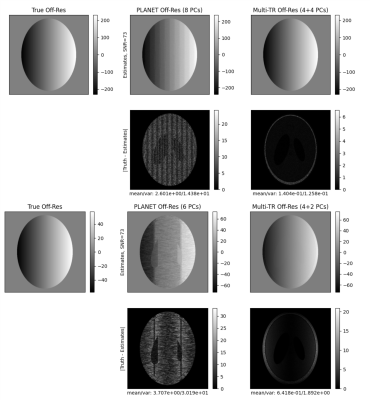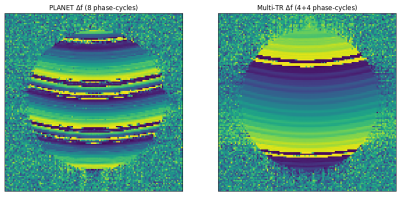Nicholas McKibben1, Michael Mendoza2, Neal K Bangerter2, and Michael N Hoff3
1University of Utah, Salt Lake City, UT, United States, 2Department of Bioenginnering, Imperial College London, London, United Kingdom, 3Deptartment of Radiology, University of Washington, Seattle, WA, United States
1University of Utah, Salt Lake City, UT, United States, 2Department of Bioenginnering, Imperial College London, London, United Kingdom, 3Deptartment of Radiology, University of Washington, Seattle, WA, United States
We present a method to combine multiple linearly phase-cycled bSSFP
images from multiple-TR acquisitions at high flip angles and low TR
values to improve PLANET's robustness to noise while independently
estimating field maps with great accuracy using 6 or 8 phase-cycles.

Representative simulated field maps using both 8 and 6 phase-cycles (SNR=73). The PLANET field maps required phase-unwrapping while the proposed methods did not. The proposed methods in each case outperform PLANET field maps. The PLANET residual image contains artifacts due to the streak-banding caused by the linear off-resonance which can be seen in the estimate. PLANET with 6 phase-cycles performs poorly even in good SNR conditions using single or multiple TR-ellipses. Proposed methods result in good field maps, improving by an order of magnitude in almost every case.

Field map estimates from a cylindrical phantom. A modified TrueFISP pulse sequence with 200 dummy pulses ensured steady state. 8 linearly spaced phase-cycles between 0 and 2$$$\pi$$$ at TR=6ms and FA=70° were acquired for the single ellipse PLANET (left) while 4 linearly spaces phase-cycles were acquired for each of two TR-ellipses (TR1=6ms, TR2=12ms) (right). The PLANET field map estimate (left) suffers from phase wrapping and artifacts due to the high FA while the proposed multi-TR estimate only suffers from discontinuities due to the large difference between TR1 and TR2.